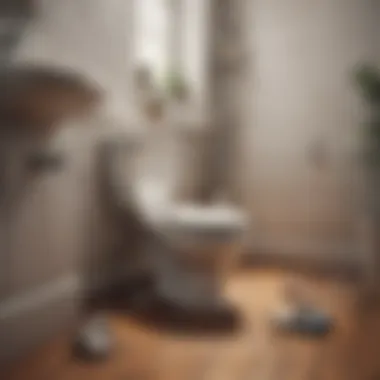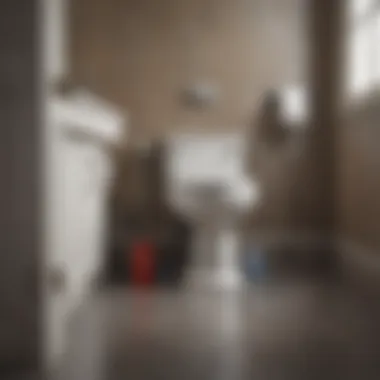Comprehensive Guide to Addressing a Clogged Toilet


Intro
Addressing a clogged toilet is a common household issue that many encounter at some point. Understanding the underlying causes, methods of resolution, and preventive strategies is crucial in managing this problem effectively. This guide delves into the various aspects of toilet clogs, including frequent culprits that contribute to blockage and practical solutions you can implement. Additionally, it highlights the significance of grasping plumbing systems in your home and outlines when it is appropriate to enlist professional help.
In this exploration, we aim to equip the reader with both knowledge and practical skills that can minimize frustrations associated with toilet malfunctions. A strategic approach can not only resolve current issues but also provide insights to avoid future difficulties.
Causes of Clogs
Clogs can stem from several sources. Understanding these can help in both prevention and resolution.
- Excessive Toilet Paper: One of the most common reasons for blockages is the use of too much toilet paper. The toilet's flushing capacity may be compromised when paper accumulates.
- Foreign Objects: Items such as toys, hygiene products, or even excessive wipes can inadvertently be flushed. These materials do not dissolve and lead to clogs.
- Root Intrusion: In some cases, tree roots can infiltrate sewer lines, leading to blockages further down the line.
- Aging Pipes: Older plumbing systems may have deteriorating pipes that are more susceptible to clogs.
Recognizing these causes can aid in early intervention and strategies for addressing clogs.
Techniques for Unclogging
Several methods exist for unclogging a toilet, catering to different types of blockages. Some are more effective than others depending on the nature of the clog.
- Plunger: A traditional yet effective tool, using a plunger can help dislodge obstructions. Make sure to use a flange plunger, specifically designed for toilets.
- Plumbing Snake: This tool can reach deeper clogs that a plunger cannot resolve. It operates by breaking up or pulling out the blockages.
- Baking Soda and Vinegar: For a less mechanical approach, a mixture of these two common household items can create a foaming action that may clear minor clogs.
- Wet/Dry Vacuum: This can be employed to suck out the contents of the toilet, potentially dislodging the blockage in the process.
Always take precautions, using gloves and ensuring safety when attempting these methods.
Preventive Measures
To avoid future clogs, consider the following practices:
- Limit Toilet Paper Usage: Try to use only what is necessary.
- Educate Household Members: Ensure everyone knows what can and cannot be flushed.
- Regular Maintenance: Inspect plumbing systems regularly to catch small issues before they escalate.
When to Seek Professional Help
Understanding when to call a professional is key. If you are unable to resolve a clog after multiple attempts or if you notice persistent drainage issues, it may indicate a more significant underlying plumbing problem. Professionals have the tools and expertise to diagnose and rectify such issues efficiently.
"Regular maintenance and awareness of common issues can alleviate much of the frustration that comes from plumbing problems."
Culmination
Being informed about the issues surrounding clogged toilets enables individuals to take proactive measures. By understanding causes, employing effective techniques, and implementing preventative strategies, the likelihood of facing severe plumbing issues can be significantly reduced. Knowledge not only empowers homeowners but also ensures a smoother, more functional living environment.
Understanding the Clogged Toilet


Dealing with a clogged toilet can be a frustrating experience. Understanding this common household issue is crucial for several reasons. First, gaining knowledge about why clogs happen can help individuals prevent future occurrences. Additionally, by understanding the potential causes, home owners can make informed decisions on whether to tackle the issue themselves or seek professional assistance.
When one understands the mechanics behind a clogged toilet, it becomes easier to recognize the signs early on. This awareness leads to quicker resolutions, reducing the likelihood of water damage or plumbing catastrophes. Moreover, it enables a person to adopt the right maintenance practices, which can save time and money in the long run.
Overall, addressing the underlying reasons for a clogged toilet supports better household management and enhances one's living environment.
What Causes a Clogged Toilet
There are several common factors that can lead to a clogged toilet. Understanding these causes can prevent unnecessary stress:
- Excessive Toilet Paper: One of the most frequent culprits. If too much toilet paper is used at once, it may not break down properly and can block the pipes.
- Foreign Objects: Items such as toys, feminine products, or personal hygiene items are often accidentally flushed. Such objects can easily create blockages.
- Grease Buildup: Over time, grease and fatty substances from flushable wipes or other materials can accumulate in the plumbing, causing clogs.
- Tree Roots: In older homes, tree roots may grow into sewage pipes, disrupting the flow and leading to blockages.
- Pipe Issues: Age, deterioration, or misaligned pipes can create challenging areas for waste disposal, often resulting in clogs.
Common Myths About Toilet Clogs
Myths about toilet clogs can lead to misconceptions that may complicate the situation. Here are a few prevalent myths:
- Myth 1: All toilet paper is created equal. Not all toilet paper is designed to break down in water. Certain brands are thicker and may contribute to clogs more easily than others.
- Myth 2: Flushable wipes are safe to flush. Though marketed as flushable, many wipes do not disintegrate like toilet paper. This can lead to blockages in pipes.
- Myth 3: A clogged toilet is only an inconvenience. The truth is, ignoring a clog can result in larger plumbing issues and expensive repairs if not addressed promptly.
- Myth 4: You can flush anything down the toilet. While toilets are designed for human waste and toilet paper, many other items should never be flushed. It is important to be cautious about what goes into the toilet.
Understanding these myths and the causes of clogs can empower readers. It helps in making well-informed decisions, both about usage and preventative measures.
Immediate Actions to Take
Tackling a clogged toilet can be frustrating and stressful. However, knowing how to respond quickly and effectively can alleviate some of that anxiety. The immediate actions taken right after detection of a clog play a crucial role in not only preventing further damage to the plumbing system but also in reducing inconvenience in your daily routine. This section highlights essential steps such as assessing the situation and gathering necessary tools, ultimately setting the stage for resolving the blockage efficiently.
Assessing the Situation
The first step when facing a clogged toilet is to assess the situation carefully. Understanding the nature and severity of the clog can influence how you proceed. Here are several considerations to keep in mind:
- Observe the Water Level: If the water level in the toilet bowl is rising, this could indicate a severe blockage. It's critical to act quickly to avoid overflow.
- Check for Overflowing: If the water threatens to spill over, shutting off the water supply immediately can prevent flooding. Locate the shut-off valve, usually found behind the toilet, and turn it clockwise.
- Identify Possible Causes: Consider what may have caused the clog. Common culprits include excessive toilet paper, foreign objects, or even plumbing issues.
By taking the time to assess the situation, you can tailor your approach to fix the problem more effectively. Recognizing the potential risks also informs you whether to attempt a DIY fix or call a professional.
Gathering Necessary Tools
Once you have assessed the situation, the next step is to gather the necessary tools to effectively tackle the clog. Having the right equipment on hand can streamline the unclogging process, making it more efficient. Some of the essentials include:
- Plunger: A high-quality flanged plunger is ideal for toilet clogs. It creates a better seal and can generate more pressure than a standard sink plunger.
- Toilet Auger: Also known as a plumber's snake, this tool is excellent for reaching deeper clogs that a plunger cannot affect effectively.
- Bucket: Keep a bucket nearby in case of overflow or spills during the process. It can also help to contain excess water from the bowl if you need to remove it manually.
- Rubber Gloves: Always wear rubber gloves to protect your hands while dealing with unpleasant situations.
By preparing these tools in advance, you reinforce your ability to respond effectively, which can save valuable time and prevent complications that may arise from an unresolved clog.


"Effective preparation often translates into effective resolution."
Unclogging Techniques
In dealing with a clogged toilet, implementing effective unclogging techniques is crucial. These techniques can help address minor to moderate clogs, minimizing frustration and restoring functionality to your bathroom. Understanding the correct methods to use can save time and potential costs associated with professional plumbing services. Proper techniques will not only help in resolving the immediate issue but also contribute to the overall maintenance of the toilet over time.
Using a Plunger
The plunger is perhaps the most recognized tool for unclogging toilets. Its design allows for the creation of a suction force, which typically dislodges the blockage. When using a plunger, ensure that it has a flange, as this is more effective for toilets compared to standard cup plungers. Firmly position the plunger over the drain hole, maintaining a tight seal. Use quick, forceful thrusts downward followed by gentle upward pulls. This method often frees up clogs caused by items like toilet paper or human waste, restoring normal flow.
Employing a Toilet Auger
A toilet auger, or plumbing snake, is another essential tool for more stubborn blockages. This tool is designed with a long, flexible metal cable and a specialized head that can navigate the bends of the toilet’s trap. When using a toilet auger, insert the coiling cable into the toilet and crank the handle to extend it into the drain, reaching deeper clogs that refuse to budge under conventional methods. This is particularly useful when the blockage is too far down the pipe for a plunger to be effective, making the toilet auger an indispensable tool for homeowners.
Chemical Drain Cleaners
Chemical drain cleaners present an alternative approach for tackling clogs. These substances break down materials obstructing pipes and can be an additional option when mechanical methods fail. However, they should be used judiciously.
Types of Chemical Cleaner
Common types of chemical cleaners include caustic, acidic, and enzymatic cleaners. Caustic cleaners utilize lye and can effectively dissolve organic waste. They are popular due to their immediate action. Acidic cleaners, on the other hand, rely on sulfuric acid and must be used carefully, as they can damage fixtures if not handled properly. Enzymatic cleaners are safer options that use natural enzymes to break down waste over time. Their unique feature lies in their non-toxic nature, making them more environmentally friendly; however, they may require longer to show results compared to caustic or acidic types.
Risks and Safety Precautions
Using chemical cleaners carries inherent risks. Many contain harsh ingredients that can cause burns or respiratory issues if proper precautions are not taken. Always wear gloves and protective eyewear when handling these chemicals. It is crucial to read and follow the instructions on the label carefully. If a chemical cleaner does not work, avoid mixing it with other products, as this can create dangerous chemical reactions. Overall, these precautions enhance safety, making the attempt to clear a clog less hazardous and more effective.
Using Hot Water and Dish Soap
A simpler, yet effective technique involves using hot water and dish soap. This method can help loosen clogs caused by grease or organic matter without the need for chemical agents. Pour a generous amount of dish soap into the toilet bowl, allowing it time to penetrate the blockage. Follow up by carefully pouring hot (but not boiling) water from waist height. This method can soften the clog and allow it to wash away more easily with the flow of the toilet. It is a straightforward approach that can yield positive results, particularly for minor clogs or build-up accumulation.
When to Seek Professional Help
Addressing a clogged toilet may seem straightforward, but there are instances when professional intervention is necessary. Understanding when to call a plumber can save one from further complications and potential damage to the plumbing system. Professional plumbers possess specialized tools and knowledge that home remedies lack. They can accurately identify underlying issues, which are not always visible.
Signs You Need a Plumber
Recognizing the signs that indicate the need for professional help is crucial. Some common indicators include:
- Persistent clogs that do not respond to standard unclogging methods.
- Frequent backups or overflowing toilets, which can signal deeper plumbing problems.
- Strange noises, such as gurgling sounds, arising from the toilet or drains.
- Water pooling around the base of the toilet, suggesting a potential leak.


If any of these issues arise, it can be wise to contact a plumber.
Understanding Plumbing Systems
Comprehending the basic functions of plumbing systems can demystify the causes of toilet clogs and prevent future issues. It is good to know how components such as pipes, valves, and connectors work together. This awareness makes discussing issues with a plumber more effective.
How Your Toilet Functions
Toilets rely on a few essential parts. The tank fills with water, and when the flush handle is activated, a chain pulls a flapper open. This allows water to flow from the tank into the bowl, enabling waste to exit through the drain. A critical aspect to understand is the siphoning action. Once the water level in the bowl drops below a certain point, the siphoning process pulls waste away, relying on gravity and proper venting.
The key characteristic of this system is its closed-loop design, which helps maintain hygiene and efficiency. However, improper maintenance or excessive waste can disrupt this system, leading to clogs. Knowing this will aid in recognizing when an issue is too complex for DIY methods.
Common Plumbing Issues
Toilets can face various common plumbing issues, like overflows, leaks, and clogs. Each of these issues can stem from normal wear and tear or improper use.
One unique feature of plumbing is its interdependence. The effectiveness of the toilet can directly affect the overall plumbing system in your home. Drainage issues in one area can lead to problems in another. Homeowners often overlook this, potentially increasing repair costs.
Understanding these aspects of plumbing helps demystify recurring problems and highlights when it is time to seek professional assistance. If the situation continues after attempts at resolution, calling in a professional is often the best course of action.
Preventive Measures
Preventive measures play a crucial role in maintaining the smooth operation of your toilet and plumbing system. A proactive approach not only minimizes the likelihood of future clogs but also saves time, effort, and potential costs associated with plumbing repairs. Understanding how regular care and mindful use of your toilet can significantly reduce issues is key in this discussion. By adopting some simple yet effective strategies, you can create a more efficient and less stressful bathroom environment.
Regular Maintenance Tips
Implementing maintenance practices will help keep your toilet functioning correctly. Here are some practical suggestions:
- Inspect Regularly: Check your toilet for leaks or cracks. This simple inspection can prevent more severe issues later on.
- Clean the Toilet: Regular cleaning helps avoid mineral buildup and stains that can lead to blockages. Use products compatible with your toilet's materials.
- Monitor Water Quality: Hard water can lead to mineral buildup in plumbing. If you notice issues related to this, consider using a water softener.
- Flush Properly: Avoid flushing items that might cause clogs, such as wipes, paper towels, or feminine hygiene products. Teach everyone in your household what is safe to flush.
"Regular maintenance can prevent most plumbing issues. A few minutes spent checking and cleaning can save significant time and money in the future."
Best Practices for Toilet Use
Awareness of how to use your toilet effectively can prevent costly clogs and maintenance. Here are some best practices to consider:
- Educate Household Members: Ensure that everyone understands the importance of what can and cannot be flushed. This is particularly important in homes with children.
- Use Enzyme-based Cleaners: These are more effective than standard cleaners for breaking down organic waste without damaging your plumbing.
- Manage Your Usage: If your toilet is older or has persistent issues, consider limiting its use for non-disposable waste when possible.
- Be Cautious with Bulk Toilet Paper: Use toilet paper that dissolves easily, especially if you have previously experienced clogging issues.
Incorporating these preventive measures can lead to a more reliable plumbing system, enhancing the overall functionality and experience of your bathroom.
Culmination
Understanding how to properly address a clogged toilet is essential for every homeowner. It not only saves time but also prevents further complications that may require costly repairs. This article has covered the fundamental aspects of toilet clogs, helping you navigate from basic understanding to practical solutions.
Recap of Key Points
- Understanding the Causes: Identifying the primary causes of clogs aids in addressing the problem effectively. Common issues like excessive toilet paper or foreign objects can lead to blockages.
- Immediate Actions to Take: Knowing how to assess the situation and gather necessary tools is crucial. This preparation sets the tone for effective troubleshooting.
- Unclogging Techniques: Various methods are discussed, such as using a plunger, toilet auger, or even hot water and dish soap. Understanding these techniques enables homeowners to choose the most effective one given the specific circumstances.
- When to Seek Professional Help: Recognizing signs that require professional intervention is important. Issues beyond a simple clog could indicate more significant plumbing problems that need specialized attention.
- Preventive Measures: Regular maintenance and best practices can significantly reduce the frequency of clogs, thus prolonging the lifespan of the toilet and plumbing system.







